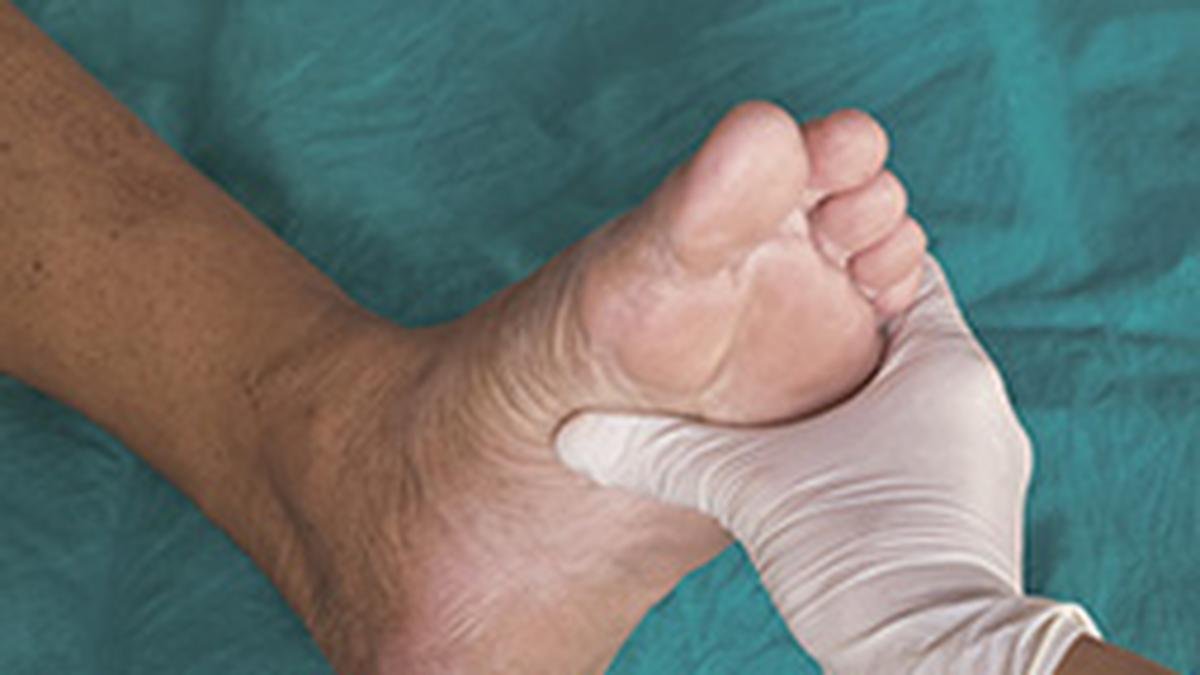All you need to know about: Diabetic Foot

An organ that can be severely affected in people with diabetes, is the foot. Photograph used for representational purposes only
| Photo Credit: Getty Images/iStockphoto
Everyone knows that diabetes is a condition when your blood sugar levels are higher than they should be. But when these levels are consistently high over a long period of time, they begin to damage your body’s tissues and organs. One of the organs that can be severely affected is your feet. With India leading the world in the number of people with diabetes, at an estimated 101 million, it is crucial to understand what uncontrolled diabetes can do to the feet and how this can be prevented.
What is diabetic foot?
Diabetic foot conditions occur when, over time, high blood glucose levels damage the nerves and blood vessels in the feet.
The nerve damage, known as diabetic neuropathy, can cause numbness (loss of feeling), pain or tingling in the feet. The numbness can make it hard for patients to tell when they have any sort of cut or blister on their foot, potentially delaying treatment.
People with diabetes are also at increased risk of developing peripheral artery disease, a condition in which narrowed arteries reduce the blood flow to the legs.
The neuropathy and poor blood flow can increase the risk of foot ulcers (wounds or sores), and slow healing. A combination of these factors puts many diabetic patients at risk of foot ulcers that get infected and do not heal well. Left untreated, these infections can spread further, ultimately leading to tissue death or gangrene, which could result in an amputation.
How common is this condition?
A recent study by Vijay Viswanathan et al, published in BMJ Open Diabetes Research & Care, of over 33,000 participants pan India, found that one-fourth of people with diabetes has ‘High Risk’ Feet. The paper also said India faces an increasing burden of foot-related problems among people with diabetes and pointed out that hospitalisation costs were significantly higher in people with diabetic foot complications compared with people with other diabetic complications.

Who is at risk of diabetes foot?
According to the U.S. Centers for Disease Control and Prevention, anyone with diabetes can develop nerve damage but some factors increase the risk:
Blood sugar levels that are hard to manage; having diabetes for a long time, especially if your blood sugar is often higher than your target levels; being overweight; being older than 40 years; having high blood pressure; having high cholesterol.
Smoking is also a risk factor: smoking can damage blood vessels and can lower blood flow to the feet. The BMJ study found that 12.6% of participants were in the habit of smoking, and they had 2.3 times higher odds of having ‘feet at risk’ compared with those who did no smoke.
What are the symptoms of diabetic foot?
Symptoms can vary, but may include: changes in skin colour and temperature, thickened, yellow toenails, cuts/blisters that don’t heal, ingrown toenails, loss of sensation/ability to feel temperature, pain, tingling or burning, loss of hair on lower legs and feet and dry, cracked skin. It is essential to see your doctor as soon as possible if symptoms develop.

How is diabetic foot treated?
Doctors may treat the foot in a number of ways including removing dead skin and tissue, known as debridement, applying medication and dressing the ulcer, getting weight taken off the affected foot via special footwear, wheelchair/crutches (known as off-loading), prescribing antibiotics and managing blood glucose levels.
One of the complications of diabetic foot is gangrene. This is a dangerous complication that can develop when blood supply to a tissue is cut off, causing the tissue to die. Early treatment reduces the risk of gangrene and amputation, which is why awareness about foot conditions in diabetes is important.
How do you prevent diabetic foot?
Prevention is key when it comes to diabetic foot. Checking your feet every day and taking good care of them play a vital role here. A 2016 paper, Diabetic Foot Infection: An Indian Scenario, in The Journal of Foot and Ankle Surgery points out that diabetic foot infections in India are often a consequence of wounds caused by a person wearing footwear that is not sufficiently protective or that is ill-fitting or not wearing footwear at all. Delays in seeking treatment, treating the wounds/ulcers with home/herbal remedies, a lack of health-related education, no healthcare services nearby as well as a lack of financial resources all contribute to the problem.
Using well-fitted footwear, washing your feet every day in warm water, drying them and moisturising them, trimming toenails, maintaining blood flow to the feet through gentle exesrcises, and having your doctor check your feet during visits can all help.
Diabetic foot ulcer and diabetic foot infections have long-term implications for persons living with diabetes in the form of morbidity and mortality. Early recognition, classification, diagnosis, and treatment of foot complications are needed to optimise outcomes in patients with diabetes, the paper said.
Published – February 12, 2025 07:13 pm IST



Post Comment